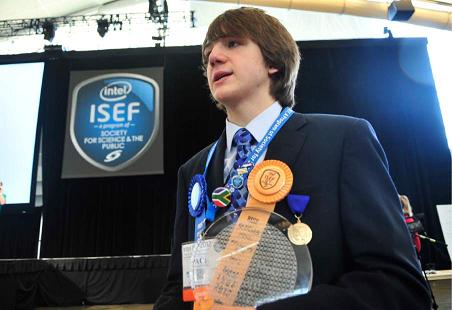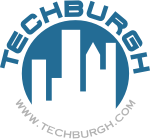
Image Via Pittsburgh TribuneReview
Who says American intuition is dead. Jack Andraka, a high school student from Maryland has developed a new method to detect Pancreatic Cancer. Jack had entered the Intel International Science and Engineering Fair. Jack created a dipstick sensor that could detect Early Stage Pancreatic Cancer in subjects blood or urine, that is accurate over 90% of the time. The test he developed is 28% faster, 28% cheaper, and over 100% more sensitive than current tests. Congratulations Jack and to all the other winners. Read the press release below from Intel.
Jack Andraka of Crownsville, Md. Wins Top Prize at Intel International Science and Engineering Fair
NEWS HIGHLIGHTS
- The world’s largest high school science research competition, the Intel International Science and Engineering Fair, a program of Society for Science & the Public, announced its top winners in Pittsburgh, Pa.
- Jack Andraka of Crownsville, Md. received the Gordon E. Moore Award, a $75,000 prize named in honor of the Intel co-founder, retired chairman and CEO.
- Two Intel Foundation Young Scientist Awards winners – Nicholas Schiefer of Pickering, Ontario, Canada and Ari Dyckovsky of Leesburg, Va. – each received prizes of $50,000 from the Intel Foundation.
PITTSBURGH, Pa., May 18, 2012 – Jack Andraka, 15, of Crownsville, Md. was awarded first place for his new method to detect pancreatic cancer at this year’s Intel International Science and Engineering Fair, a program of Society for Science & the Public. Based on diabetic test paper, Jack created a simple dip-stick sensor to test blood or urine to determine whether or not a patient has early-stage pancreatic cancer. His study resulted in over 90 percent accuracy and showed his patent-pending sensor to be 28 times faster, 28 times less expensive and over 100 times more sensitive than current tests. Jack received the Gordon E. Moore Award, named in honor of Intel co-founder and retired chairman and CEO of $75,000.
Two students, Nicholas Schiefer, 17, of Pickering, Ontario, Canada and Ari Dyckovsky, 18, of Leesburg, Va., each received the Intel Foundation Young Scientist Award of $50,000.
Nicholas studied what he calls “microsearch,” or the ability to search the fastest-growing information medium: small amounts of content, such as tweets and Facebook status updates.Through his research, Nicholas hopes to improve search engines’ capabilities, which will in turn improve access to information.
Ari investigated the science of quantum teleportation. He found that once atoms are linked through a process called “entanglement,” information from one atom will just appear in another atom when the quantum state of the first atom is destroyed. Using this method, organizations requiring high levels of data security, such as the National Security Administration, could send an encrypted message without running the risk of interception because the information would not travel to its new location; it would simply appear there.
“We support the Intel International Science and Engineering Fair because we know that math and science are imperative to future global growth,” said Wendy Hawkins, executive director of the Intel Foundation. “This competition encourages millions of students to engage their skills for innovation and develop promising solutions for global challenges.”
This year, more than 1,500 young scientists were chosen to compete in the Intel International Science and Engineering Fair. They were selected from 446 affiliate fairs in approximately 70 countries, regions and territories. In addition to the winners mentioned above, more than 400 finalists received awards and prizes for their groundbreaking work. Awards included 17 “Best of Category” winners who each received a $5,000 prize. The Intel Foundation also awarded a $1,000 grant to each winner’s school and to the affiliated fair they represent.
The following lists the 17 Best of Category winners, from which the top three were chosen:
| Category | First | Last | City | State/Country |
|---|---|---|---|---|
| Animal Sciences | Lucy | Hritzo | Holland | Pa. |
| Behavioral and Social Sciences | Benjamin | Kornick | Roslyn Heights | N.Y. |
| Biochemistry | Rebecca | Alford | Commack | N.Y. |
| Cellular and Molecular Biology | Raghav | Tripathi | Portland | Ore. |
| Chemistry | Raghavendra | Ramachanderan | Bengaluru | India |
| Computer Science | Nicholas | Schiefer | Pickering, Ontario | Canada |
| Earth and Planetary Sciences | Mofeed | Sawan | London, Ontario | Canada |
| Engineering: Electrical and Mechanical | Assiya | Kussainova | Karaganda, Karagandy | Kazakhstan |
| Engineering: Materials and Bioengineering | Ryota | Ishizuka | Cos Cob | Conn. |
| Energy and Transportation | Shyamal | Buch | Folsom | Calif. |
| Environmental Management | Adam | Noble | Lakefield, Ontario | Canada |
| Environmental Sciences | Naomi | Shah | Portland | Ore. |
| Mathematical Sciences | Aishwarya | Vardhana | Beaverton | Ore. |
| Medicine and Health | Jack | Andraka | Crownsville | Md. |
| Microbiology | Felix | Angelov | Skokie | Ill. |
| Physics and Astronomy | Ari | Dyckovsky | Leesburg | Va. |
| Plant Sciences | Huihui | Fan | Staten Island | N.Y. |
Society for Science & the Public, a nonprofit membership organization dedicated to public engagement in scientific research and education, owns and has administered the International Science and Engineering Fair since its inception in 1950, as the National Science Fair.
“We congratulate Jack, Nicholas, and Ari on their success here at the Intel International Science and Engineering Fair,” said Elizabeth Marincola, president of Society for Science & the Public. “They and all the other finalists here this week further demonstrate how a background of STEM [science, technology, engineering, and math] education creates the breeding ground for creativity and ingenuity that will help solve the pressing issues of the future.”
The Intel International Science and Engineering Fair includes some of the most promising rising student entrepreneurs, innovators and scientists from around the world. Finalists are selected annually from hundreds of affiliated fairs. Their projects are then evaluated onsite by more than 1,200 judges from nearly every scientific discipline, each with a Ph.D. or the equivalent of 6 years of related professional experience in one of the scientific disciplines.
A full listing of finalists is available in the event program (beginning on page 57). The Intel International Science and Engineering Fair 2012 is funded jointly by Intel and the Intel Foundation with additional awards and support from dozens of other corporate, academic, governmental and science-focused organizations.
To learn more about SSP, and its programs and publications, visit www.societyforscience.org, follow on Twitter, or visit the Facebook page.
To get the latest Intel education news, visit www.intel.com/newsroom/education, and join the conversation on Facebook and Twitter.
About Intel
Intel (NASDAQ: INTC) is a world leader in computing innovation. The company designs and builds the essential technologies that serve as the foundation for the world’s computing devices. Additional information about Intel is available at newsroom.intel.com and blogs.intel.com.
Intel is a trademark of Intel Corporation in the United States and other countries.
- Other names and brands may be claimed as the property of others.
SOURCE: INTEL



 Fifteen-Year-Old Creates Non-Invasive Pancreatic Cancer Detection Tool
Fifteen-Year-Old Creates Non-Invasive Pancreatic Cancer Detection Tool
